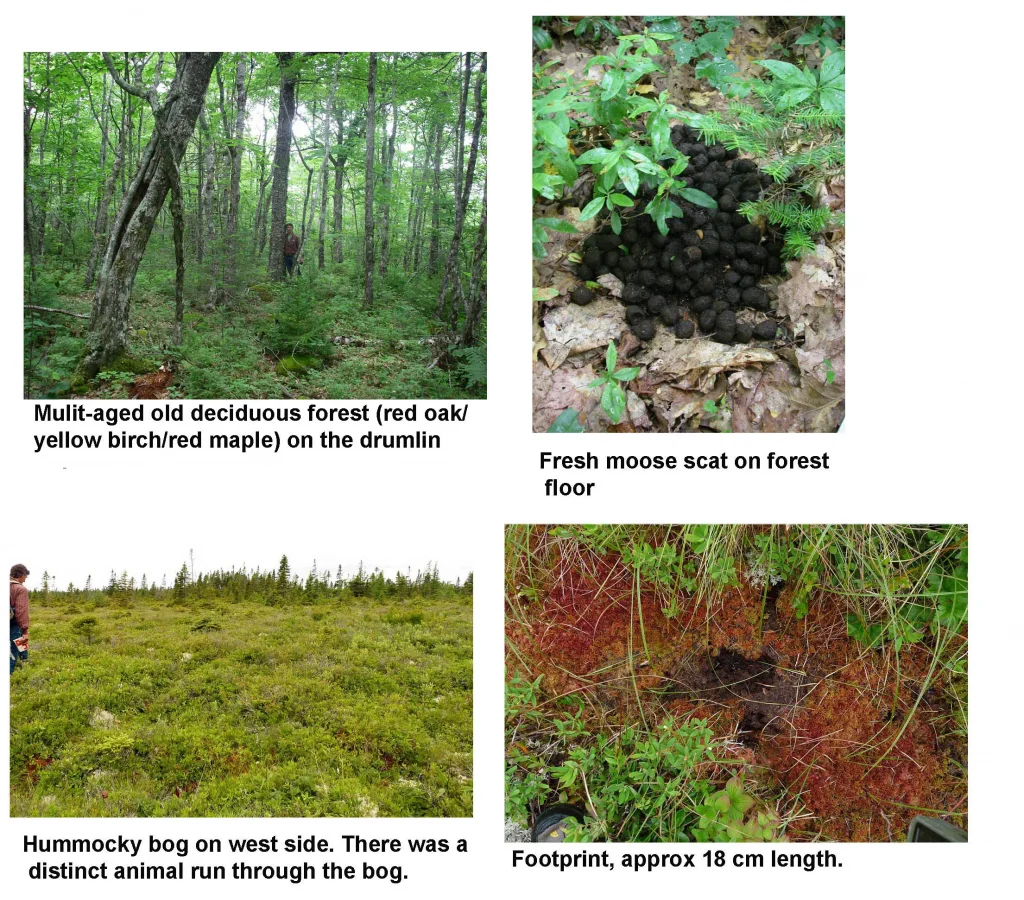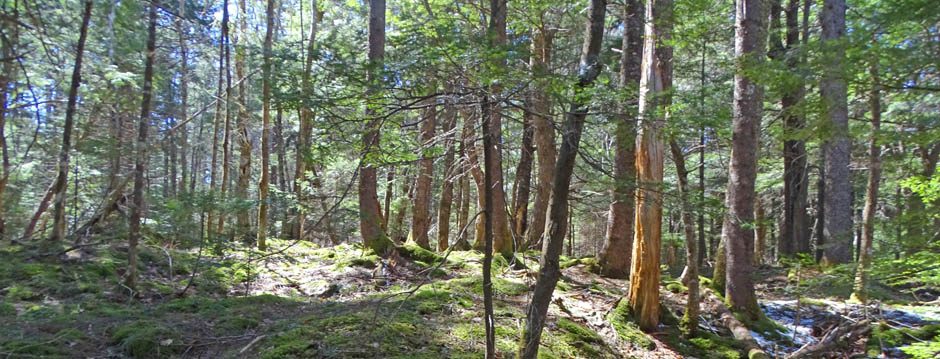| The pages and subpages on Moose:
MOOSE
|
More on the Chebucto Moose
In the 2000s, minimum numbers cited from several surveys of moose on the Chebucto peninsula were 25 to 28 individuals (cited in Highway 113 EA 2009, p. 168). It was further commented:
This population on the Chebucto Peninsula are not considered sustainable by NSDNR and as such there is no area specific recovery plan in place (Tony Nette, NSDNR personal communication, 2009). Specifically, the surveys conducted in 2003, 2008 and 2009 suggest the Chebucto population is more or less stable. A combination of ground and winter aerial surveys along with radio tagging suggests they are no longer moving off of the Chebucto Peninsula. The NSDNR continue to solicit sightings from the public of live animals, scat or antlers as part of its ongoing surveys. The NSDNR suggest that the Chebucto moose in particular seem very wary of humans, whether on foot or on ATVs and off-highway vehicles (OHVs) (Tony Nette, NSDNR personal communication, 2009).
and on page 233:
Impacts on mainland moose and deer and fragmentation/impacts on existing ecological integrity of the area (includes Blue Mountain/Birch Cove Lakes) Studies by NSDNR on the spatial distribution and abundance of Mainland Moose have shown that there is a small population that exists on Chebucto Peninsula but several winter aerial and radio-tracking studies have shown that this small population limits its range to the Chebucto Peninsula and the range would not be fragmented by the proposed highway (Hwy 113] as the population does not usually venture close to the proposed alignment or the Blue Mountain/Birch Cove Lakes Wilderness Area. TIR will provide a structure between Maple and Fraser Lake with an opening large enough for large mammals to pass. Therefore, impacts on mainland moose and deer are not significant.
At the time, moose sightings on the Chebucto Peninsula were quite common, and protection of core habitat for Mainland Moose on the Chebucto Peninsula was high amongst the reasons a group of over 35 community organizations cited for protection of the Five Bridge Lakes Wilderness Area (FBLWA) in the centre of the Chebucto Peninsula. (View Chebucto Wilderness Committee Newsletter report # 10, Aug 17, 2009)
In 2010, co-chairs of the Woodens River Watershed Environmental Organization (WRWEO) wrote a lengthy letter to the Environmental Assessment Branch of Nova Scotia Environment expressing concerns about comments by NSNDR in the Highway 113 EA on the state of the Chebucto Moose, notably that
- “this small population limits its range to the Chebucto Peninsulaand the range would not be fragmented by the proposed highway as the population does not usually venture close to the proposed alignment or the Blue Mountain/Birch Cove Lakes Wilderness Area
- “This population on the Chebucto Peninsula are not considered sustainable by NSDNR and as such there is no area specific recovery plan in place”
The co-chairs cited evidence that Moose do, apparently, migrate above Highway 103, likely in higher frequency than suggested. They commented further,
We are quite disappointed (if not disheartened, given our history in efforts to realize protection for FBLWA) by the statement that “This population on the Chebucto Peninsula are not considered sustainable by NSDNR and as such there is no area specific recovery plan in place.” We suggest that maintenance and enhancement of this group should be a priority for the following reasons:
(a) By this logic, even some, most or all of the larger groups might be considered non-viable by wildlife demographers…
(b) The Mainland Moose is a legally protected species, which requires, we understand, protection of all groups, regardless of size. …
(c) The small, more isolated groups should not be dismissed as irrelevant to long term survival of the Mainland Moose in N.S…
As we understand it from the DNR presentation in the spring at Tantallon [May 6, 2009], the Chebucto group is healthy and the area provides good habitat for them – so why not capitalize on that situation? Also, we understand, their numbers are much more easily monitored than other populations, so they are a good case study for conservation efforts. .. We have discussed at and following the DNR presentation on moose at Tantallon in the spring, the possibility of some restriction of activity on parts of the Bluff Trail seasonally, or even closing down the more remote loops… citizens are prepared to contribute to moose conservation!
(d) Conservation corridors benefit all species and are critical for long term species richness of all of the protected areas on and adjacent to the Chebucto Peninsula…
(e) The Chebucto moose are potentially an invaluable tool for promoting conservation, perhaps even for bringing additional funds…
View the letter for more content
The letter illustrates some contradiction of then DNR’s view with the view expressed in the 2021 Recovery Plan in regard to migration, i.e. that the Chebucto Moose are a small isolated group that doesn’t migrate (versus the Recovery Plan dismissing the Chebucto Moose because of limitations to migration imposed by highways). It is notable also that the population while small was considered stable and more accurately survivable than other populations, further that DNR personnel commented at the Tantallon presentation the Chebucto group is healthy and the area provides good habitat for them. It also illustrates the interest and commitment of local groups which is reflected in the broad support in Halifax (HRM) for conservation generally and to addressing connectivity needs

Moose signs in muliti-aged oak -dominated hardwood forest on Umlah Hill and in adjacent wetland in the Five Bridge lakes Wilderness Area in July, 2009 Source: Photographs of an Old Growth Red Oak stand on the Chebucto Peninsula (Nova Scotia). More info about the site in this slide presentation.

